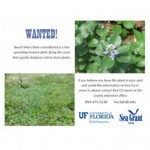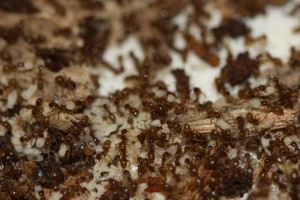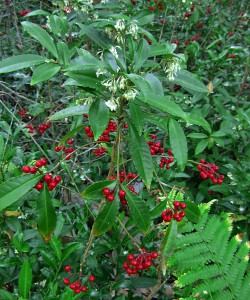
March 1st: Coral Ardisia (Ardisia crenata), Beach Vitex (Vitex rotundifolia), Crazy Ant (Nylanderia pubens)
Early Detection Rapid Response (EDRR): All of the species featured in today’s article are ones that we need to keep an eye on as they move closer to the Florida panhandle. If new invasive species are caught early, then eradication of that species from the area becomes easier.
Coral Ardisia (Ardisia crenata):
Coral ardisia is also known as coral berry, spice berry, and scratchthroat. It was introduced into Florida in the early 1900′s for ornamental purposes.
In the ensuing years, it has since it escaped cultivation and has become established in hardwood hammocks and other moist woods of natural areas and grazing lands. Populations can currently found in Florida, Louisiana and Georgia.
This evergreen sub-shrub reaches a height of 1.5 to 6 feet and tends to grow in multi-stemmed clumps. Leaves are alternate, 8 inches long, dark green above, waxy, without hairs, and have scalloped margins and calluses in the margin notches. Flowers are typically pink to white in stalked axillary clusters, usually drooping below the foliage. The fruit is a bright red, globose, single-seeded berry, measuring approximately 0.25 inches in diameter. White-berried populations are also known to exist.
Coral ardisia is classified a Category I weed on the Florida Exotic Pest Plant Council Invasive Plant List. Control of coral ardisia may be accomplished by two methods. A low-volume foliar application of Garlon 4 or Remedy provides suppression of this plant. Complete foliar coverage is essential to success and retreatment will be necessary for complete control. Basal bark applications with Garlon 4 or Remedy in an oil carrier can also be utilized for suppressing this invasive weed. Do not apply more than 8 quarts of Remedy or Garlon 4 per acre and treat no more than ten percent of the total grazed area if applying greater than two quarts per acre.
More information is available at http://edis.ifas.ufl.edu/ag281.
For local assistance, contact your county UF IFAS Extension office.
For more information contact Les Harrison, Agriculture & Natural Resources Extension Agent by phone at 850-926-3931.
Beach Vitex (Vitex rotundifolia):
![Rick-Wanted-Poster-300x228[1]](http://nwdistrict.ifas.ufl.edu/nat/files/2014/02/Rick-Wanted-Poster-300x2281.jpg)
Click Image to Download Wanted Poster. Please circulate to area residents to provide visual identification of Beach Vitex. Contact your Extension Office for control options and help reduce it’s impact on native species.
Originally from the Pacific rim of Asia, Beach Vitex was brought to South Carolina to help restore dunes lost during storms. Also known as round-leaved chaste tree and pohinahina, this low-growing shrub does very well in coastal habitats. The plant is a small, deciduous shrub that can grow to a height of 3 feet and forms root and rhizome masses extending over 60 feet from the parent plant. The stems are fleshy when young but become woody with age. The leaves are simple and measure 1 – 2.5 inches in length, are ovate, and dark green on top while lower surface is light green to silver. Locally it flowers in the spring producing beautiful purple to light blue flowers. The fruit forms in mid-summer and are charcoal gray color.
Rapid growth and dense fruit production allows this plant to quickly dominate dune habitats, in some cases covering over 85% of the dune field and crowding out natives such as sea oats. The plant is also known to produce its own chemical weapons to help outcompete native species. Coverage is so thick in some areas the term “beach kudzu” is now being used. Conservation groups believe that this dense growth will negatively impact sea turtle nesting (both for egg laying adults and hatching young). In 2009 the plant was listed on North Carolina’s Noxious Weed List and there is now a statewide task force to combat this invasive. It was first reported in our area on Pensacola Beach. There are 13 known locations on Pensacola Beach and it could very well be found in other panhandle locations. If you suspect you have the plant you may contact your local Extension office for information on how to safely remove it. For more information visit www.beachvitex.org
For more information, contact the author Rick O’Connor, Sea Grant/Marine Sciences Agent 850-475-5230.
Caribbean Crazy Ant (Nylanderia pubens):
Also known as the “Hairy Crazy” and the “Brown Crazy Ant,” the Caribbean Crazy Ant originated in the Caribbean Islands. The ants were most likely introduced by accident to Miami in the 1950’s. For 50 years very little was said about the ant until their numbers began to increase in the West Palm Beach area around the year 2000. They have now migrated as far north as the Jacksonville area. The name “crazy ant” describes their movement. This ant does not sting, but rather bites with its mandibles and is considered an annoying pest. These ants swarm in large numbers and are found mostly outside, but have infested homes and even caused shortages in electrical systems. They do not form mounds but rather nest in leaf litter,

Caribbean Crazy Ants and their brood courtesy of UF/IFAS read more at http://edis.ifas.ufl.edu/in889
debris, potted plants, garbage cans, and landscape features; quickly relocating when disturbed. This reddish-brown, medium sized (2.5-3.0mm), ant is sometimes mistaken for the fire ant, but differs in having stripes on its abdomen. Caribbean crazy ant workers are the same size; whereas the fire ant workers vary in size. They feed on protein (insects) and their diet may vary seasonally. They are rarely seen in large numbers during the winter months, which suggests they may form several nests and gather with increasing temperatures. They can be confused with the ant Prenolepis impairis, found in north Florida. However P. imparis has an hour-glass shaped alitrunk behind the head, which is not found on the Caribbean Crazy Ant. Scientists from Texas A&M University have determined that the “Raspberry Crazy Ant” of the Houston area is in fact the same species.
Eradication is not probable and the homeowner may need professional help to remove them. Pesticides have not been very effective and homeowners should be aware the pest control professionals are restricted in how they spray each year, so requesting more applications will not be an option. An integrated pest management plan will be needed. To reduce the chance of infestation homeowners should de-clutter their yards and homes, watch where you leave food, seal entry points into homes, and trim vegetation away from the house.
For more information visit: www.entnemdept.ufl.edu/creatures/urban/ants/caribbean_crazy_ant.htm
For more information, contact the author Rick O’Connor, Sea Grant/Marine Sciences Agent 850-475-5230.
![]()
Posted: March 16, 2014
Category: Invasive Species, Natural Resources
Tags: Ardisia, Beach, Coral, Crazy, Invasive, March, Panhandle Outdoors, Species, Vitex…
![NISAW-logo09[1]](http://nwdistrict.ifas.ufl.edu/nat/files/2014/02/NISAW-logo091.jpg)


